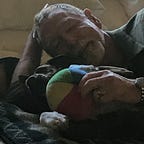Geiger Trumps GlobalEntry (or, tips for traveling while radioactive)
In October 2012, I was diagnosed with prostate cancer. After considering all the options, I elected to go through a procedure called Brachytherapy. This involves volumetric measurement of one’s prostate, and the subsequent insertion of around 100 rice-grain-sized “seeds” made of titanium and filled with Iodine 125, a radioactive isotope. The seeds are permanent, the idea being a longish-term, highly-localized dose of radiation to kill off the cancer. The half-life of Iodine 125 is about six months. At the end of the procedure, I was issued a wallet card identifying me, the procedure and the isotope: the seeds can be detectable when crossing international boundaries. It’s essentially an “I’m radioactive but it’s okay” card.
On a subsequent flight to Mumbai, there were TSA agents in the jetway at Seatac, checking passports. As I approached one of them, a little box on his belt began to buzz. I thought it was a pager, but he actually looked a bit scared for a moment and asked “is there anything you want to tell me?” First some confusion and then aha. I showed him my wallet card, and he started breathing easier and waived me on. No big deal.
I travel quite a bit, much of it internationally, and for reasons unexplained I tend to get pulled into secondary screening every time I enter back into the U.S. I decided to go through the effort to get a GlobalEntry ID in the hopes it would streamline my travel experience. On my return from Mumbai, Seatac Immigration was jam-packed, so I was glad to be able to walk past the crowds to a bank of 4 GlobalEntry kiosks, nobody using any of them. I placed my hand in the scanner, posed for a photo, tapped a few things on the touch screen and was on my merry in about 30 seconds. Awesome.
I thought I was home free — until, as I handed my Customs Declaration to the CBP officer, one of those same little boxes buzzed. My radiation card didn’t much impress this guy — other officers separated me from my luggage and led me to a waiting area where they brought out a shoebox-sized device with a handle on the top that started ticking when it got near me. The agent explained, in very slllloooww speach, that “this is a very expensive instrument that looks for radiation.” I said “um, yeah, it’s a Geiger counter.” (It’s actually a Geiger-Müller counter, but whatever.) The agent was surprised and responded “oh, you must be a scientist.” Said Geiger counter recorded my pattern but couldn’t match it against some database of “okay” forms, and so the sample had to be emailed to “a scientist on the Internet” (FEMA?) for verification. I ended up sitting for 30 minutes before I was cleared.
I’d like to think that in the age where we have TSA, CPB, PreCheck, GlobalEntry and the concept of a trusted traveler, the systems might somehow be connected in a productive way. Once I’d been identified with a specific isotope, and determined to have a proper explanation, it would be great to have that included as part of my trusted traveler profile. I posed that as a suggestion on the CPB website and received a call from a rather surly CPB agent who basically said “can’t do it, not now, not ever. Tough luck.”
Ah, the pairing of government with technology…
